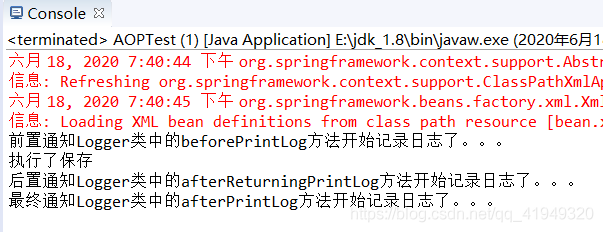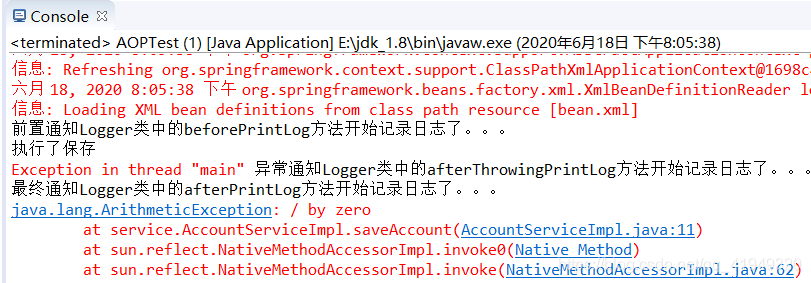SpringAOP的四種通知類型:前置通知、異常通知、后置通知、異常通知
一、四種常見的通知類型
給出 賬戶的業務層接口 IAccountService.java,
為了便于演示這四種通知類型,我們就只留下了一個方法。
public interface IAccountService {
void saveAccount();
}
給出 賬戶的業務層接口的實現類 AccountServiceImpl.java
public class AccountServiceImpl implements IAccountService{
@Override
public void saveAccount() {
System.out.println("執行了保存");
//int i=1/0;
}
}
給出一個日志類, 用于打印日志
public class Logger {
/**
* 前置通知
*/
public void beforePrintLog(){
System.out.println("前置通知Logger類中的beforePrintLog方法開始記錄日志了。。。");
}
/**
* 后置通知
*/
public void afterReturningPrintLog(){
System.out.println("后置通知Logger類中的afterReturningPrintLog方法開始記錄日志了。。。");
}
/**
* 異常通知
*/
public void afterThrowingPrintLog(){
System.out.println("異常通知Logger類中的afterThrowingPrintLog方法開始記錄日志了。。。");
}
/**
* 最終通知
*/
public void afterPrintLog(){
System.out.println("最終通知Logger類中的afterPrintLog方法開始記錄日志了。。。");
}
}
給出配置信息bean.xml
<?xml version="1.0" encoding="UTF-8"?>
<beans xmlns="http://www.springframework.org/schema/beans"
xmlns:xsi="http://www.w3.org/2001/XMLSchema-instance"
xmlns:aop="http://www.springframework.org/schema/aop"
xsi:schemaLocation="http://www.springframework.org/schema/beans
http://www.springframework.org/schema/beans/spring-beans.xsd
http://www.springframework.org/schema/aop
http://www.springframework.org/schema/aop/spring-aop.xsd">
<!-- 配置srping的Ioc,把service對象配置進來-->
<bean id="accountService" class="service.AccountServiceImpl"></bean>
<!-- 配置Logger類 -->
<bean id="logger" class="utils.Logger"></bean>
<!--配置AOP-->
<aop:config>
<!--配置切入點表達式 -->
<aop:pointcut id="pt1" expression="execution(* service.AccountServiceImpl.saveAccount())"></aop:pointcut>
<!--配置切面 -->
<aop:aspect id="logAdvice" ref="logger">
<!-- 配置前置通知:在切入點方法執行之前執行-->
<aop:before method="beforePrintLog" pointcut-ref="pt1" ></aop:before>
<!-- 配置后置通知:在切入點方法正常執行之后值-->
<aop:after-returning method="afterReturningPrintLog" pointcut-ref="pt1"></aop:after-returning>
<!-- 配置異常通知:在切入點方法執行產生異常之后執行-->
<aop:after-throwing method="afterThrowingPrintLog" pointcut-ref="pt1"></aop:after-throwing>
<!-- 配置最終通知:無論切入點方法是否正常執行它都會在其后面執行-->
<aop:after method="afterPrintLog" pointcut-ref="pt1"></aop:after>
</aop:aspect>
</aop:config>
</beans>
注意
1)異常通知和后置通知永遠只能執行一個
2)配置切入點表達式
此標簽寫在aop:aspect標簽內部只能當前切面使用。
它還可以寫在aop:aspect外面,此時就變成了所有切面可用
給出Test類
public class AOPTest {
public static void main(String[] args) {
//1.獲取容器
ApplicationContext ac = new ClassPathXmlApplicationContext("bean.xml");
//2.獲取對象
IAccountService as = (IAccountService)ac.getBean("accountService");
//3.執行方法
as.saveAccount();
}
}
執行結果:

當我們放開AccountServiceImpl類中我們故意制造的異常 int i=1/0;時:

二、環繞通知
環繞通知,只需要稍稍微改變上面例子的兩點即可
1、改動日志類 Logger.java
public class Logger {
public Object aroundPringLog(ProceedingJoinPoint pjp){
Object rtValue = null;
try{
Object[] args = pjp.getArgs();//得到方法執行所需的參數
System.out.println("Logger類中的aroundPringLog方法開始記錄日志了。。。前置");
rtValue = pjp.proceed(args);//明確調用業務層方法(切入點方法)
System.out.println("Logger類中的aroundPringLog方法開始記錄日志了。。。后置");
return rtValue;
}catch (Throwable t){
System.out.println("Logger類中的aroundPringLog方法開始記錄日志了。。。異常");
throw new RuntimeException(t);
}finally {
System.out.println("Logger類中的aroundPringLog方法開始記錄日志了。。。最終");
}
}
}
注意:pjp.proceed(args)會報異常,必須用 Throwable t,因為Exception攔不住它
2、改動配置文件
<?xml version="1.0" encoding="UTF-8"?>
<beans xmlns="http://www.springframework.org/schema/beans"
xmlns:xsi="http://www.w3.org/2001/XMLSchema-instance"
xmlns:aop="http://www.springframework.org/schema/aop"
xsi:schemaLocation="http://www.springframework.org/schema/beans
http://www.springframework.org/schema/beans/spring-beans.xsd
http://www.springframework.org/schema/aop
http://www.springframework.org/schema/aop/spring-aop.xsd">
<!-- 配置srping的Ioc,把service對象配置進來-->
<bean id="accountService" class="service.AccountServiceImpl"></bean>
<!-- 配置Logger類 -->
<bean id="logger" class="utils.Logger"></bean>
<!--配置AOP-->
<aop:config>
<!--配置切入點表達式 -->
<aop:pointcut id="pt1" expression="execution(* service.AccountServiceImpl.saveAccount())"></aop:pointcut>
<!--配置切面 -->
<aop:aspect id="logAdvice" ref="logger">
<!-- 配置環繞通知 詳細的注釋請看Logger類中-->
<aop:around method="aroundPringLog" pointcut-ref="pt1"></aop:around>
</aop:aspect>
</aop:config>
</beans>
分析
- spring中的環繞通知是spring框架為我們提供的一種可以在代碼中手動控制增強方法何時執行的方式。
- Spring框架為我們提供了一個接口:ProceedingJoinPoint。該接口有一個方法proceed(),此方法就相當于明確調用切入點方法。該接口可以作為環繞通知的方法參數,在程序執行時,spring框架會為我們提供該接口的實現類供我們使用。
AOP機制之環繞通知的見解
我們都知道,AOP機制的核心是在不修改源碼的基礎上對業務層方法的增強。
其中有五個通知類型
- 1、前置通知:在切入點方法之前執行
- 2、后置通知:在切入點方法之后通知
- 3、異常通知:在執行切入點方法過程中出現異常后執行(因此異常通知和后置通知只能執行一個)
- 4、最終通知:無論切入點方法是否正常執行它都會執行
- 5、環繞通知: 當配置環繞通知之后,在環繞通知里面必須要明確調用業務層的方法,如果不調用,就會出現只出現通知,而不執行方法。其中原理和動態代理是一樣的,代碼如下。
public AccountService getAccountService() {
return (AccountService) Proxy.newProxyInstance(accountService.getClass().getClassLoader(), accountService.getClass().getInterfaces(), new InvocationHandler() {
@Override
public Object invoke(Object o, Method method, Object[] objects) throws Throwable {
Object rtValue=null;
try {
//1、開啟事務
txManager.beginTransaction();
//2、執行操作,整個過程像對每個方法進行了包裝,并返回新的accountService對象
rtValue=method.invoke(accountService,objects);
//3、提交事務
txManager.commit();
//4、返回結果
return rtValue;
}catch (Exception e){
//5、回滾事務
txManager.rollback();
throw new RuntimeException(e);
}finally {
//6、釋放連接
txManager.release();
}
}
});
}
如果不明確調用業務層方法,就像一個畫皮,沒有發揮本質的作用。
除此之外,我認為環繞通知可以代替其他的四個通知,
public Object aroundPrintLog(ProceedingJoinPoint pjp){//環繞通知是不是能夠代替其他的通知
Object rtvalue=null;
try {
/**
*這里的一切都是為都是給業務層方法進行增強,例如:把那些方法拿過來,然后核心的還是rtvalue=pjp.proceed(args),
*其他的輸出只不過是為核心的業務層方法進行修飾
*/
Object[] args=pjp.getArgs();//得到方法執行所需的參數
System.out.println("前置通知");
rtvalue=pjp.proceed(args);//明確調用業務層方法
System.out.println("后置通知");
return rtvalue;
}catch (Throwable e){
System.out.println("異常通知");
throw new RuntimeException(e);
}finally {
System.out.println("最終通知");
}
}
這個屬于典型的環繞通知,其中把輸出方法換成相應的通知方法就可以(有不同觀點的可以說出來一起討論)。
最后,分享一下我學這個知識的方法。方法增強,本質上就是對源碼不修改的情況下進行方法的加工。就好像烤羊肉串一樣,其中的核心就是羊肉,就像公司給你的業務層方法(這個是不讓修改的)。在給顧客使用前,收先對羊肉進行刷油、烤、撒料一系列過程,這一過程就是我們對業務層方法的增強,使業務層的功能更加健壯,對應的燒烤也就是更美味。核心的一點就是正確調用業務層的方法,不管在哪類通知中,都能對業務層方法進行正確、有效地增強
以上為個人經驗,希望能給大家一個參考,也希望大家多多支持服務器之家。
原文鏈接:https://blog.csdn.net/qq_41949320/article/details/106841824













